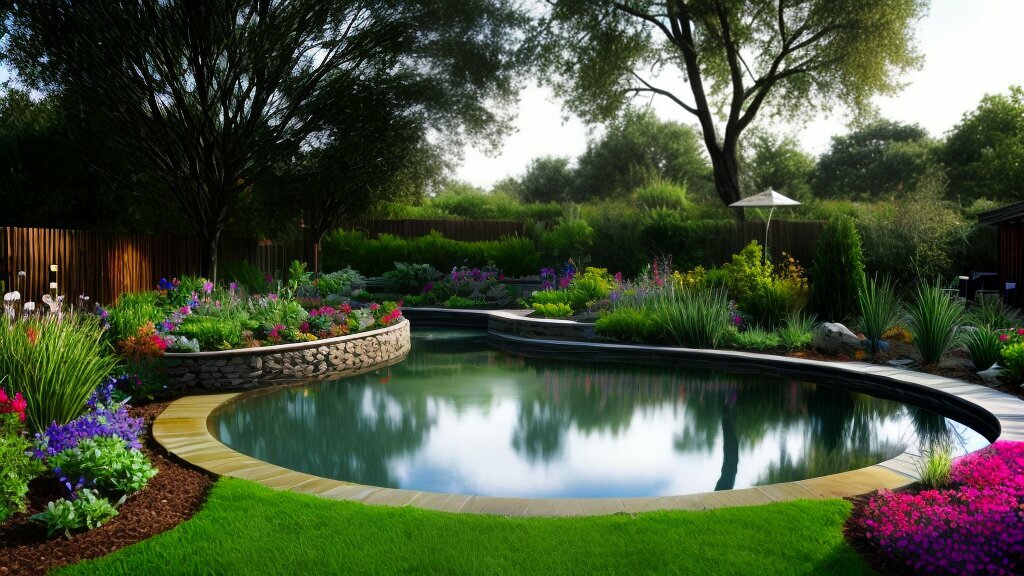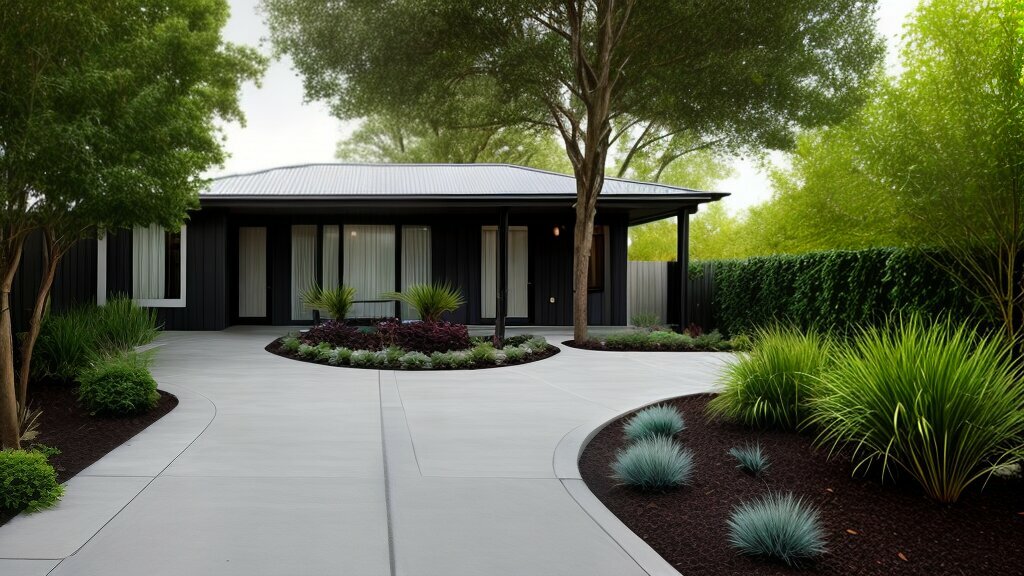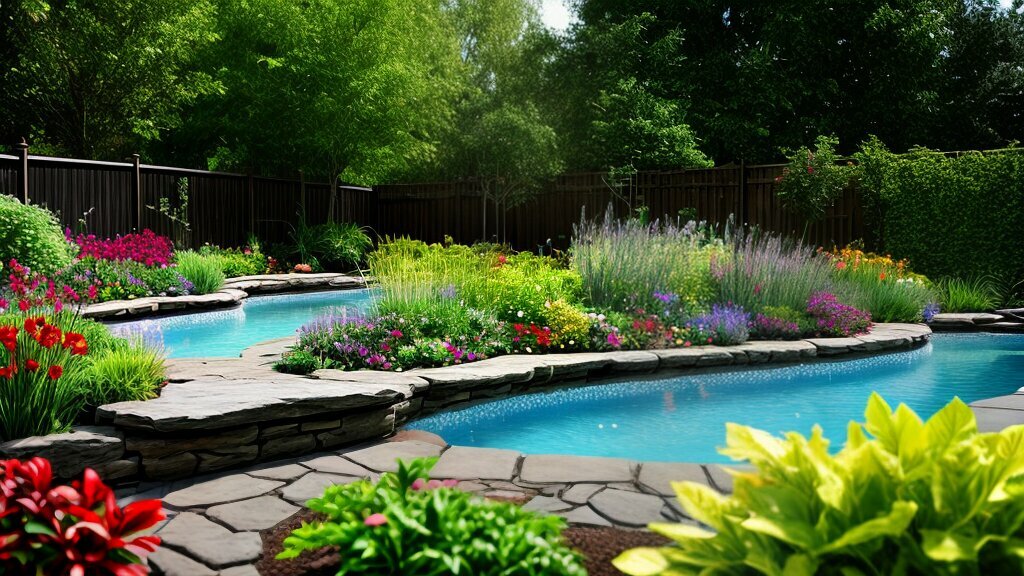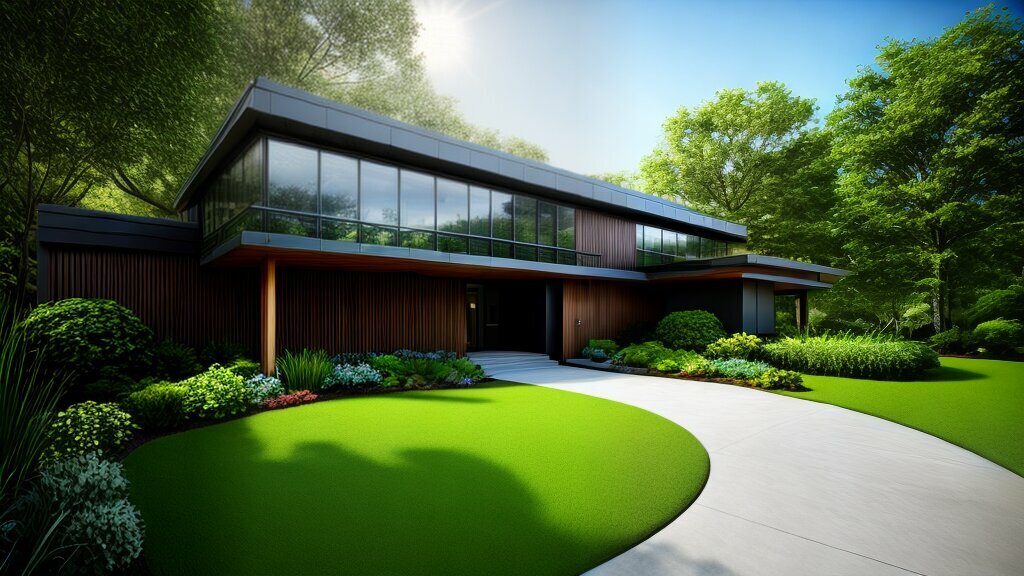Welcome to our article on Sustainable Landscaping in Building Design. Green building practices and eco-friendly techniques are no longer just trends; they are a necessity for creating a sustainable future. Landscaping plays a significant role in sustainable architecture and construction, extending far beyond aesthetics. It contributes to energy efficiency, biodiversity, ecosystem services and community well-being. Through this article, we explore the importance of sustainable landscaping practices in building design, and its various benefits for the environment and society.
Key Takeaways:
- Sustainable landscaping is essential for creating a greener future.
- Eco-friendly landscaping practices are integral to sustainable architecture and construction.
- Landscaping contributes to energy efficiency, biodiversity, ecosystem services and community well-being.
Understanding Sustainable Landscaping in Building Design
As the focus on sustainable and eco-friendly practices continues to grow, so too does the importance of sustainable landscaping in building design. Sustainable landscaping involves the use of environmentally responsible techniques and practices to create and maintain landscapes that are not only aesthetically pleasing but also contribute to the health of the environment.
Sustainable landscaping is closely related to sustainable architecture and sustainable construction, with a focus on reducing the environmental impact of building projects. Key design principles include the use of native plants, minimizing water usage, maximizing energy efficiency, and promoting biodiversity and ecosystem services.
By incorporating sustainable landscaping in building design, designers and builders can create landscapes that are not only visually appealing but also contribute to a healthier and more sustainable environment. The benefits of sustainable landscaping go beyond aesthetics, and include improved air and water quality, reduced energy use, and enhanced biodiversity.
Design principles for sustainable landscaping
There are several key design principles that contribute to sustainable landscaping in building design:
- Use of native plants: Choosing plants that are native to the local region reduces the need for irrigation, pesticides and fertilizers, and creates a habitat for local wildlife.
- Water conservation: Employing techniques such as drip irrigation, rainwater harvesting, and use of drought-tolerant plants can significantly reduce water usage.
- Energy efficiency: Maximizing the use of natural lighting and shading, incorporating green roofs and walls, and using renewable energy sources such as solar power can improve energy efficiency.
- Biodiversity and ecosystem services: Designing landscapes that support local ecosystems and promote biodiversity can have a positive impact on the environment and wildlife.
By incorporating these design principles into sustainable landscaping practices, designers and builders can create landscapes that are not only beautiful but also contribute to a healthier and more sustainable environment.

“Sustainable landscaping involves the use of environmentally responsible techniques and practices to create and maintain landscapes that are not only aesthetically pleasing but also contribute to the health of the environment.”
Environmental Benefits of Sustainable Landscaping
Aside from being aesthetically pleasing, sustainable landscaping practices offer numerous environmental benefits. Sustainable landscape management aims to reduce the negative impact of landscape design on the environment by incorporating eco-friendly strategies. From reducing water usage to enhancing biodiversity, these practices contribute to a healthier and more sustainable future.
“Sustainable landscape practices can reduce the carbon footprint of the built environment by reducing energy and resource consumption, sequestering carbon, and reducing pollution and waste.” – American Society of Landscape Architects
One of the most significant environmental benefits of sustainable landscaping is its contribution to sustainable landscape management. Utilizing eco-friendly landscape techniques, such as composting and mulching, reduces the amount of waste sent to landfills and promotes soil health and fertility. These practices also reduce the need for chemical fertilizers and pesticides, which can harm the environment and contaminate water sources.

Another key environmental benefit of sustainable landscaping is its positive impact on climate change. Sustainable landscape design can help reduce the carbon footprint of the built environment by sequestering carbon, reducing energy and resource consumption, and minimizing waste and pollution.
Additionally, sustainable landscaping practices prioritize water conservation by utilizing eco-friendly irrigation techniques and drought-resistant plant species. This not only reduces water usage but also promotes the health of local ecosystems by minimizing the impact on natural water resources and reducing soil erosion.
Sustainable landscaping practices also enhance biodiversity and ecosystem services by providing habitats for wildlife, promoting pollination, and supporting the natural balance of local ecosystems. This contributes to a healthier and more sustainable environment for both humans and wildlife.
Integrating Nature-friendly Design Elements
One of the fundamental principles of sustainable landscaping in building design is the integration of nature-friendly design elements. These elements aim to reduce the environmental impact of building projects while enhancing the look and feel of the landscape.
Nature-friendly design elements include features such as green roofs, which use vegetation to insulate buildings, reduce stormwater runoff and provide habitat for wildlife. Additionally, green walls can be used to improve air quality and reduce energy consumption by providing shade and insulation.
Another effective element of sustainable landscape design is the use of permeable paving. This alternative paving technique allows water to seep through the surface to the underlying soil, reducing runoff and the potential for flooding. Permeable paving can also improve soil quality and support plant growth, contributing to a more sustainable and attractive landscape.
Green Infrastructure
Green infrastructure is another critical aspect of sustainable landscaping in building design. This approach involves creating natural systems and structures that provide ecological benefits while also enhancing the aesthetic appeal of the landscape. Examples of green infrastructure include rain gardens, bioswales, and constructed wetlands, which are all designed to capture and filter stormwater runoff.
Additionally, green infrastructure can help to reduce the urban heat island effect by providing shade and cooling the surrounding air. This benefit not only improves the physical comfort of people in the area but also has a positive impact on local wildlife and the environment as a whole.

Integrating nature-friendly design elements and green infrastructure is crucial for creating sustainable landscapes in building design. These features contribute to energy efficiency, water conservation, and enhanced biodiversity while also providing a beautiful and functional outdoor space.
Sustainable Site Planning for Landscaping
When it comes to sustainable landscaping, site planning plays a crucial role in creating a successful and eco-friendly design. By incorporating nature-friendly building design principles into site planning, we can reduce the negative impact of our buildings on the environment.
One of the key principles of sustainable site planning is to preserve natural features as much as possible. This includes protecting existing trees, managing drainage to minimize water runoff, and designing with the existing topography in mind. By doing so, we can reduce the need for excessive land grading and preserve the integrity of the site’s ecosystem.
Another important aspect of sustainable site planning is to maximize the use of permeable surfaces. This can include the use of permeable paving materials, green roofs, and rain gardens, all of which help to minimize stormwater runoff and reduce the burden on municipal water treatment facilities.
Furthermore, incorporating native vegetation into the landscape design can be a cost-effective and eco-friendly way to enhance biodiversity and reduce maintenance costs. Native plants are adapted to the local environment and require less water and fertilizer than non-native species, leading to a healthier and more sustainable landscape.

“Sustainable site planning involves a holistic approach to building design, considering the ecological impact of the design on the surrounding environment.”
Overall, the incorporation of sustainable site planning principles into landscaping design can have a significant impact on reducing the environmental footprint of our buildings. By embracing nature-friendly design principles, we can promote a healthier, more sustainable future for ourselves and the planet.
The Role of Plant Selection in Sustainable Landscaping
Plant selection is a crucial aspect of sustainable landscaping as it determines the ability of a landscape to thrive while using minimal resources. With the right plant choices, a landscape can reduce the need for irrigation, fertilizers, and pesticides, and contribute to a healthy ecosystem.
One important consideration in plant selection is the ability of a plant to thrive in the local climate and soil conditions. Native plants are often the best choice as they are adapted to the local environment and require less maintenance. They also provide habitat for local wildlife and contribute to biodiversity.
Another factor to consider is the plant’s water requirements. Choosing plants that are drought-tolerant and require little irrigation can significantly reduce water usage in a landscape. Xeriscaping, or landscaping with plants that require minimal water, has become a popular trend in sustainable landscaping.
It is also important to consider the plant’s maintenance needs. Plants that require frequent pruning or fertilization can be resource-intensive and may not be the best choice for a sustainable landscape. Choosing low-maintenance plants can help to reduce the need for costly and environmentally damaging maintenance practices.
Overall, selecting the right plants for a sustainable landscape can have a significant impact on the environment and the long-term health of the landscape. By choosing plants that are adapted to the local environment, require minimal resources, and support biodiversity, a sustainable landscape can thrive while contributing to a healthier planet.

Water Conservation in Sustainable Landscaping
One of the key benefits of incorporating sustainable landscaping in building design is the ability to conserve water. Traditional landscaping practices often involve excessive watering and irrigation, leading to wastage and increased water bills.
However, through the use of sustainable landscape techniques, you can minimize water usage and promote eco-friendly practices. One strategy is to select plant species that are adapted to the local climate and soil conditions. These plants require less watering and are better equipped to withstand drought conditions.
Another technique is to incorporate native plants into the landscape design. These plants are naturally suited to the local environment and require minimal irrigation once established. They also provide habitat for local wildlife and contribute to biodiversity.

Green infrastructure is another effective approach to water conservation in sustainable landscaping. This involves the use of permeable surfaces, such as porous pavements and green roofs, which allow rainwater to infiltrate into the ground rather than being directed into stormwater drainage systems. This reduces the strain on municipal water supplies and helps to prevent flooding and erosion.
Finally, sustainable landscaping practices such as mulching and composting can help retain moisture in soil and improve soil health, reducing the need for irrigation.
Maximizing Energy Efficiency through Landscaping
As we have seen in previous sections, sustainable landscaping in building design goes beyond aesthetics. It can also contribute significantly to energy efficiency and reduce carbon footprint. By incorporating sustainable design principles and green building practices, we can create an energy-efficient landscape that complements the building itself.
One of the ways to maximize energy efficiency through landscaping is by strategically selecting the location and orientation of trees and other plants. Trees can provide shade in the summer, reducing the need for air conditioning, and allow more sunlight in the winter, reducing the need for artificial heating. Similarly, strategically placed shrubs and bushes can help block wind, further reducing heating costs.
Another technique for energy-efficient landscaping is the use of permeable paving materials. These materials allow rainwater to seep into the soil, reducing the need for irrigation and minimizing runoff. Additionally, permeable paving materials can help regulate temperature, reducing the urban heat island effect.

Green roofs and green walls are also excellent ways to maximize energy efficiency through landscaping. Green roofs, or vegetated roof covers, provide insulation for the building, reducing the need for artificial heating and cooling. They also absorb rainwater, which further reduces runoff. Similarly, green walls, or vertical gardens, can provide insulation, reduce heat gain, and improve air quality.
Finally, lighting plays a significant role in energy consumption. By using low-energy lighting, such as LED lights, and strategically placing lighting fixtures, we can further reduce energy usage and minimize light pollution, which can negatively impact wildlife.
Enhancing Biodiversity and Ecosystem Services
Sustainable landscaping offers numerous benefits to the environment, including improving biodiversity and ecosystem services. By integrating eco-friendly practices in building design, we can create healthier and more sustainable living spaces that promote a balanced and thriving ecosystem.
The careful selection of plant species plays a crucial role in enhancing biodiversity. By choosing native plants that are adapted to the local climate and soil conditions, we can create habitats that support local flora and fauna. This not only promotes biodiversity but also helps to restore ecological balance.
| Benefits of enhancing biodiversity |
How sustainable landscaping contributes |
| Increase soil fertility and nutrient cycling |
Composting and using organic mulches to promote soil health, planting diverse plant species to encourage microorganisms, and creating rain gardens to filter pollutants. |
| Enhance pollination and seed dispersal |
Planting flowers that attract pollinators and creating habitats for birds and bees |
| Improve air and water quality |
Using sustainable landscape management techniques such as rainwater harvesting, green roofs, and natural irrigation systems to reduce water and air pollution. |
Additionally, sustainable landscaping also helps to maintain and enhance ecosystem services. The provision of ecosystem services such as air and water purification, soil stabilization, and carbon sequestration is essential to the well-being of human society. By adopting eco-friendly practices, we can create landscapes that support these services and maintain a healthy environment for all.

Nurturing Community Engagement and Well-being
Sustainable landscaping in building design not only benefits the environment but also plays a vital role in nurturing community engagement and well-being. By incorporating eco-friendly practices and green building design principles, we create healthier and more enjoyable living spaces that promote social interaction and well-being. Through sustainable landscaping, we can create shared spaces that encourage people to come together and interact, fostering a sense of community and connection.
Nature is a powerful healer, and incorporating sustainable landscaping in building design can help improve mental and emotional well-being. Green spaces reduce stress and anxiety, improve mood and cognitive function, and promote physical health. When we prioritize sustainable landscaping in our building projects, we create spaces for people to connect with nature, relax and recharge, and enjoy the benefits of spending time outdoors.
Beyond promoting personal well-being, sustainable landscaping in building design also promotes social well-being and community engagement. Green spaces create opportunities for people to come together and engage in various activities, such as gardening, playing, and social events. These shared experiences help build relationships, foster a sense of belonging, and strengthen communities.
Example:
“We have a beautiful green space in our building that provides a perfect place for us to connect and unwind. It’s a great spot for picnics, yoga, and just enjoying nature. Our community has grown stronger since we started enjoying this green space together.”
Incorporating sustainable landscaping in building design is not just about creating beautiful outdoor spaces; it’s also about creating spaces that bring people together, foster community engagement, and promote personal and social well-being. By prioritizing eco-friendly practices and green building design principles, we can create a greener, healthier, and more connected future.

Conclusion
In conclusion, sustainable landscaping in building design goes beyond just aesthetics. It offers numerous environmental benefits, enhances biodiversity and ecosystem services, and nurtures community engagement and well-being.
By understanding the principles of sustainable construction and architecture, and applying nature-friendly design elements and sustainable landscape techniques, we can create eco-friendly landscaping that promotes energy efficiency and water conservation.
Plant selection plays a vital role in sustainable landscape management, and careful consideration of the species we use can have a positive impact on the environment.
With the right sustainable site planning, we can create a greener and healthier future, one that benefits both humans and wildlife alike. So let’s embrace eco-friendly practices and green building design principles, and create a sustainable landscape that we can all be proud of.
FAQ
Q: What is sustainable landscaping in building design?
A: Sustainable landscaping in building design refers to the practice of using eco-friendly techniques and design principles to create landscapes that have a positive impact on the environment. It involves incorporating green building design principles, utilizing nature-friendly elements, and promoting sustainable landscape management.
Q: What are the environmental benefits of sustainable landscaping?
A: Sustainable landscaping offers numerous environmental benefits. It helps in sustainable landscape management, conserves water, enhances biodiversity, and promotes ecosystem services. Additionally, it contributes to minimizing energy usage and reducing the overall carbon footprint of building projects.
Q: How can nature-friendly design elements be integrated into sustainable landscaping?
A: Nature-friendly design elements can be integrated into sustainable landscaping by using techniques such as green infrastructure, incorporating native plant species, creating habitats for wildlife, and implementing sustainable drainage systems. These elements help enhance the ecological value of the landscape and promote a healthier environment.
Q: What is the role of plant selection in sustainable landscaping?
A: Plant selection plays a crucial role in sustainable landscaping. By carefully choosing plant species that are native, drought-tolerant, and require low maintenance, sustainable landscape management can be achieved. Proper plant selection enhances the eco-friendliness of the design and contributes to a sustainable and resilient landscape.
Q: How can water conservation be achieved in sustainable landscaping?
A: Water conservation in sustainable landscaping can be achieved through various techniques. These include installing efficient irrigation systems, using rainwater harvesting methods, implementing water-wise planting practices, and incorporating water-saving design elements such as permeable paving. Minimizing water usage helps promote eco-friendly landscaping practices.
Q: How does landscaping contribute to maximizing energy efficiency in building design?
A: Landscaping can contribute to maximizing energy efficiency in building design by incorporating sustainable design principles and green building practices. Features such as strategic tree placement for shade, windbreaks, and green roofs can help regulate temperature, reduce the need for heating and cooling, and create an energy-efficient landscape.
Q: How does sustainable landscaping enhance biodiversity and ecosystem services?
A: Sustainable landscaping enhances biodiversity and ecosystem services by providing habitats for wildlife, supporting pollinators, and creating a balanced ecological environment. By incorporating native plants, creating diverse ecosystems, and minimizing the use of pesticides and chemicals, sustainable landscape management can enhance the natural biodiversity and ecological balance.
Q: What role does sustainable landscaping play in nurturing community engagement and well-being?
A: Sustainable landscaping plays a significant role in nurturing community engagement and well-being. By creating green spaces that are aesthetically pleasing, promoting outdoor activities, and incorporating green building design principles, it contributes to creating healthier and more enjoyable living spaces for communities to connect and thrive.



























Post comments (1)